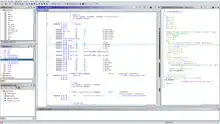Ghidra
Ghidra (pronounced gee-druh;[3] /ˈɡiːdrə/[4]) is a free and open source reverse engineering tool developed by the National Security Agency (NSA) of the United States. The binaries were released at RSA Conference in March 2019; the sources were published one month later on GitHub.[5] Ghidra is seen by many security researchers as a competitor to IDA Pro.[6] The software is written in Java using the Swing framework for the GUI. The decompiler component is written in C++, and is therefore usable in a stand-alone form.[7]
 | |
 Disassembly of a file in Ghidra | |
| Original author(s) | NSA |
|---|---|
| Initial release | March 5, 2019 |
| Stable release | 10.4[1]
/ September 29, 2023 |
| Repository | github |
| Written in | Java, C++ |
| License | Apache License 2.0 / Public domain[2] |
| Website | ghidra-sre |
Scripts to perform automated analysis with Ghidra can be written in Java or Python (via Jython),[8][9] though this feature is extensible and support for other programming languages is available via community plugins.[10] Plugins adding new features to Ghidra itself can be developed using a Java-based extension framework.[11]
History
Ghidra's existence was originally revealed to the public via Vault 7 in March 2017, but the software itself remained unavailable until its declassification and official release two years later.[5]
In June 2019, Coreboot began to use Ghidra for its reverse engineering efforts on firmware-specific problems following the open source release of the Ghidra software suite.[12]
Ghidra can be used, officially,[13][14] as a debugger since Ghidra 10.0. Ghidra's debugger supports debugging user-mode Windows programs via WinDbg, and Linux programs via GDB.[15]
See also
References
- "Releases · NationalSecurityAgency/ghidra". GitHub. Retrieved 2023-09-29.
- "ghidra/NOTICE". GitHub.com. Retrieved 13 April 2019.
- "Frequently asked questions". GitHub.com. Retrieved 7 March 2019.
- "Come Get Your Free NSA Reverse Engineering Tool!". YouTube.com. Archived from the original on 2021-12-15. Retrieved 17 May 2019.
- Newman, Lily Hay. "The NSA Makes Ghidra, a Powerful Cybersecurity Tool, Open Source". Wired. Retrieved 6 March 2019.
- Cimpanu, Catalin. "NSA releases Ghidra, a free software reverse engineering toolkit". ZDNet. Retrieved 2019-03-07.
- e. g. as Plugin for Radare2 oder Rizin.
- "Ghidra Scripting Class". GitHub. Retrieved 2023-02-19.
- "Three Heads are Better Than One: Mastering NSA's Ghidra Reverse Engineering Tool" (PDF). GitHub. Retrieved 2019-09-30.
- "Ghidraal". GitHub. Retrieved 2023-02-19.
- "Ghidra Advanced Development Class". GitHub. Retrieved 2023-02-19.
- "Coreboot Project Is Leveraging NSA Software To Help With Firmware Reverse Engineering".
- "Compiled/built Ghidra 9.3 for Windows with Debugger feature by Galician R&D Center in Advanced Telecommunications employees".
- "Analizando el depurador de Ghidra". 11 March 2021.
- "What's new in Ghidra 10.0".
- "Rob Joyce on Twitter". Twitter.com. Retrieved 6 March 2019.
- "List of Processors Supported by Ghidra". Github.com. Retrieved 29 September 2023.